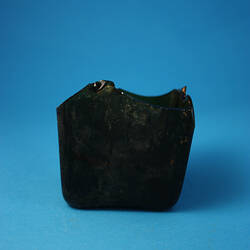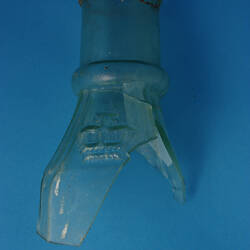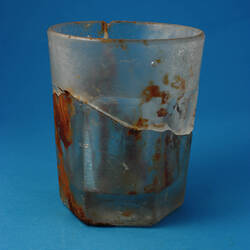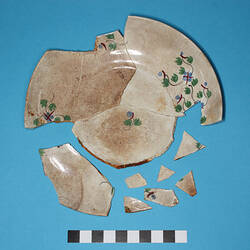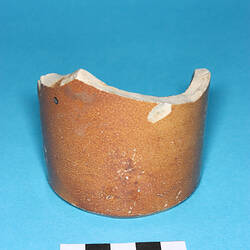This collection of 93 objects was excavated from a cesspit in Irish labourer John Maloney's backyard, during an archaeological dig of the 'Little Lon' district in 1988.
During the mid to late-19th century, 'Little Lon' developed as a working class district, with simple houses, cottage industries, small-scale businesses and later a few larger factories. The area was characterised by a network of narrow laneways, with small properties packed together creating crowded and unsanitary conditions. 'Little Lon' was home to the city's poorest residents and many new immigrants from countries around the world. It was also Melbourne's 'red light' district. The poor, illiterate, transient, 'working' population of Little Lon led to the area gaining a reputation for being a shady, disreputable slum.
The Maloney family were the longest established residents in Casselden Place, with five siblings living in the street over a forty-six year period. John was an Irish labourer who had migrated to Victoria from County Clare in 1849. After some years on the goldfields John arrived back in Melbourne in 1855 and purchased a small three-room wooden cottage in Casselden Place.
John lived in the cottage with his younger brother Edward and his elder sister Hannah. John's younger sister Margaret also came to live in the house sometime after her husband's death in 1866. Their eldest brother Thomas also settled in Casselden Place, running a carting business for many years from his home.
The objects in this collection provide a glimpse into the Maloney's daily life, including what they ate, drank and wore, and to some extent their values and beliefs. The bones indicate that the Maloney's diet included sheep, cow and chicken. While rat and mouse bones were also found in the pit, butchering marks on many of the bones allow us to identify food from vermin.
Much of the china found in the cesspit is flawed with misaligned, smudged, or uneven designs, indicating that they were seconds or rejects. However the large quantity suggests that the Maloney's were keen to demonstrate respectability. This is further supported by several pieces of Spode china, some of it made between 1829 and 1833, suggesting it was passed on from an earlier generation and brought with the Maloney's from Ireland, or purchased second-hand in Australia. The remains of at least four Staffordshire figures were also found in the cesspit, including the 'Death of Nelson', signifying that the Maloney's had enough disposable income to purchase decorative ornaments and challenging the slum stereotype commonly applied to the Little Lon district.
The relative absence of buttons found in the assemblage suggests that these items were an expensive commodity, recycled rather than thrown away when clothing wore out.
The Maloney's may have been illiterate, unskilled, Irish and working class, yet this collection shows us that they were not passive victims of poverty. They were hardworking, finding modest success in business, and maximised their meagre assets to create a warm domestic environment.
References:
Mayne, A., Murray, T. & Lawrence, S. (2000) 'Melbourne's 'Little Lon' ', Australian Historical Studies, 31 (114). pp.131-151
More Information
-
Keywords
archaeological sites, archaeology, domestic life, Cultures and histories : Melbourne and Victoria, Melbourne
-
Authors
-
Article types





